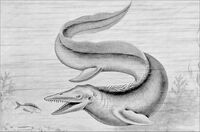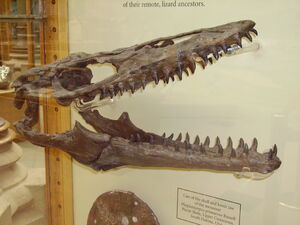| iMosasaurs
| ||||||||||||
|---|---|---|---|---|---|---|---|---|---|---|---|---|
 An etching of Mosasaur
| ||||||||||||
| Scientific classification | ||||||||||||
| ||||||||||||
|
Halisaurinae |
Mosasaurs, from Latin Mosa meaning the 'Meuse river' in the Netherlands, where the first fossil remains were discovered about 1780, and Greek sauros meaning 'lizard', were serpentine marine reptiles. These ferocious marine predators are considered by some experts to be closely related to snakes, due to extreme similarities in jaw and skull anatomies.[1] Mosasaurs were not dinosaurs but lepidosaurs, reptiles with overlapping scales. These predators evolved from semi-aquatic squamates known as the aigialosaurs, close relatives of modern-day monitor lizards, in the Early Cretaceous Period. During the last 25 million years of the Cretaceous Period (Turonian-Maastrichtian), with the extinction of the last ichthyosaurs and the decline of the Cretaceous plesiosaurs and pliosaurs, mosasaurs became the dominant marine predators.
Known genera include Clidastes, Mosasaurus, Prognathodon, Globidens, Plotosaurus, Plesiotylosaurus, Carinodens, Dallasaurus, Igdamanosaurus, Halisaurus, Tylosaurus, Platecarpus, Selmasaurus, Plioplatecarpus, Amphekepubis, Goronyosaurus, Liodon, Moanasaurus, Pluridens, Lakumasaurus, Yaguarasaurus, Eonatator, Hainosaurus, Tethysaurus, Angolasaurus, Kourisodon and Russellosaurus.
Description

Mosasaur skull Oxford University Museum of Natural History.
Mosasaurs breathed air and were powerful swimmers that were well-adapted to living in the warm, shallow epicontinental seas prevalent during the Late Cretaceous Period. Mosasaurs were so well adapted to living in shallow epicontinental seas that they gave birth to live young, rather than return to the shore, as sea turtles do, to lay eggs.
The smallest-known Mosasaur was Carinodens belgicus, which was about 3 to 3.5 m long and probably lived in shallow waters near shore, cracking mollusks and sea urchins with its bulbous teeth. Larger mosasaurs were more typical: mosasaurs ranged in size up to 17 m: Hainosaurus holds the record for longest mosasaur, at 17.5 m.
Mosasaurs had a body shape similar to that of modern-day monitor lizards (varanids), but were more elongated and streamlined for swimming. Their limb bones were reduced in length and their paddles were formed by webbing between their elongated digit-bones. Their tails were broad and supplied the locomotor power. This method of locomotion may have been similar to that used by the conger eel or sea snakes today. The animal may have lurked and pounced rapidly and powerfully on passing prey, rather than hunting for it.
Mosasaurs had a double-hinged jaw and flexible skull (much like that of a snake), which enabled them to gulp down their prey almost whole, a snakelike habit that has helped identify the unmasticated gut contents fossilized within mosasaur skeletons. A skeleton of Tylosaurus proriger from South Dakota included remains of the diving seabird Hesperornis, a marine bony fish, a possible shark and another, smaller mosasaur (Clidastes). Mosasaur bones have also been found with shark teeth embedded in them.
Based on features such as the double row of pterygoid ("flanged") teeth on the palate, the double-hinged jaw, modified/reduced limbs and probable methods of locomotion, many researchers believe that snakes and mosasaurs may have had a common ancestor. This theory was first suggested in 1869, by Edward Drinker Cope, who coined the term "Pythonomorpha" to include them. The idea lay dormant for more than a century, before being revived in the 1990s.[2] [3]
Environment
Sea levels were high during the Cretaceous Period, causing marine transgressions in many parts of the world and a great inland seaway in what is now North America. Mosasaur fossils have been found in the Netherlands, in Sweden, in Africa, in Australia, in New Zealand and on Vega Island, off the coast of Antarctica. In Canada and the United States, complete or partial specimens have been found in Alabama, Mississippi, Tennessee, and Georgia (U.S. state) and in almost all the states covered by the seaway: Texas, southwest Arkansas, New Mexico, Kansas,[4] Colorado, Nebraska, the Dakotas and Montana. Mosasaurs are also known from California, Mexico, and Peru.
Many of the 'dinosaur' remains found on New Zealand—a volcanic island arc that has never been part of a continent—are actually mosasaurs and plesiosaurs, another group of Mesozoic predatory marine reptiles.
Discovery

The Mosasaur discovered in a Maastricht limestone quarry, 1780 (contemporary engraving).
The first publicized discovery of a fossil mosasaur preceded any dinosaur fossil discoveries and drew the Age of Enlightenment's attention to the existence of fossilized animals; the specimen was discovered in 1780 by quarry-workers in a subterranean gallery, who quickly alerted Doctor C. K. Hoffman, a surgeon and fossil-hunter in the Dutch city of Maastricht, although rights of ownership lay with a canon of Maastricht, as owner of the overlying land.
Dr. Hoffman's correspondence among men of science made the find famous. When the Revolutionary forces occupied Maastricht, the carefully-hidden fossil was uncovered, betrayed, it is said, by a case of wine and transported to Paris, where Georges Cuvier was able to describe it for science, although le grand animal fossile de Maastricht was not actually described as a Mosasaur ('Meuse reptile') until 1822 and not given its official name, Mosasaurus hoffmanni, until 1829. Several sets of mosasaur remains, that had been discovered earlier at Maastricht but were not identified as mosasaurs until the nineteenth century, have been on display in the Teylers Museum, Haarlem, since about 1770.
The Maastricht limestone beds were rendered so famous they have given their name to the ultimate 6-million-year epoch of the Cretaceous: the Maastrichtian.
Evolutionary antecedents
Based on features such as the loosely-hinged jaw, modified/reduced limbs and probable locomation, many researchers believe that snakes may be descended from mosasaurs, a suggestion advanced in 1869, by Edward Drinker Cope, who coined the term "Pythonomorpha" to include them. The idea lay dormant for more than a century, to be revived in the 1990s.[2]
On 2005-11-16, research reported in Netherlands Journal of Geosciences, confirmed that the recently uncovered Dallasaurus turneri is an early link between land-based monitor lizards (such as the Komodo dragon) and the aquatic mosasaurs.[5]
Purported modern sightings
Although paleontologists have determined that all mosasaurs went extinct, around the same time as the dinosaurs and there's no fossil evidence of them beyond the end of the Cretaceous (Maastrichtian), some cryptozoologists feel that sporadic reports of crocodile-like sea serpents may suggest surviving mosasaurs. The Taniwha of Māori lore has also been connected to mosasaurs by journalists. However, there is no scientific evidence of any mosasaur remains since the end of the Cretaceous, 65 million years ago.
References
- ↑ Lee, 1997, "The phylogeny of varanoid lizards and the affinities of snakes," in Phil. Trans. R. Soc. Lond. B 352: 53-91.
- ↑ 2.0 2.1 http://www.palaeos.com/Vertebrates/Units/Unit260/260.100.html Cite error: Invalid
<ref>tag; name "palaeos" defined multiple times with different content - ↑ http://www.oceansofkansas.com/Greatrep.html
- ↑ Everhart, M.J. 2005. "Enter the Mosasaurs," Chapter 9 in "Oceans of Kansas: A Natural History of the Western Interior Sea." Indiana University Press, Bloomington, 322 p.
- ↑ http://www.smu.edu/smunews/dallasaurus/
External links
- Palaeos: Vertebrates: Mosasaurs
- BBC Science and Nature: Mosasaurs
- Mike Everhart and David Lewis, "Mesozoic marine monsters of the Mangahouanga": New Zealand fossil fauna
- Mike Everhart, "A day in the life of a Mosasaur": life in the Sea of Kansas, illus. by Carl Buell
- Mike Everhart, "Mosasaurus hoffmani" until 1829.
- Mosasaurus maximus mounted skeleton at University of Texas Memorial Museum